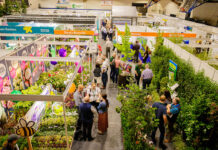As I write this article, I’m visiting my hometown of Midleton in East Cork, where recent flooding has stolen the title of locally famous liquid away from whiskey and presented it firmly to water.
What seems to be shocking to people is just how quickly the floodwater rose within the town. Climate breakdown appears to be directly implicated in the deluge of rain that hit the Owenacurra river catchment, and was then funnelled down onto Midleton’s Main Street – but there are other issues at play, too.
Specifically, land use policy and practice over the past 50 years.
With an understandable post-Second World War focus on food production at all costs, other attributes and services of the wider Irish landscape were shelved and forgotten about. Some of these include the capacity of wetlands, woodlands, hedgerows, pools and boggy corners to store water, provide habitat, support biodiversity and create space for pollinators and predator species; provide shelter, firewood and fodder; filter runoff, and regulate flood/drought cycles.
It is this last element that I want to explore today. It’s well known that when we convert farmland to urban paved surfaces, a number of distinctive patterns occur: more rainfall leaves the catchment as runoff; the speed with which it leaves increases; and inevitably, the flood peak in a storm rises. The phrase ‘flatten the curve’ could have been coined for stormwater mitigation.
When we convert farmland to urban space, the impacts are clear. But what then has happened in Midleton – an agricultural catchment with lots of farmland to catch all that rain?
What is not so immediately visible is that it’s not just urban development that interrupts the hydrological balance. Standard farming practices do, too.
When we convert habitat to farmland – and particularly when that farmland is exposed to heavy machinery, ploughing, land drainage and nitrogen fertiliser – the results are devastating for soil health, structure and moisture-holding capacity. (If devastating sounds like too dramatic a term, talk to anybody with a home or shop in Midleton.)
The same hydrological impacts are present for modern agricultural practices as for paved urban spaces: albeit in a reduced extremity per unit area, but multiplied by a much larger area. More rain shows up as surface runoff, due to compaction by heavy machinery and field drainage. The speed with which rainfall flows off the catchment is increased by the ongoing use of both ploughing and nitrogen fertilisers. These actively remove carbon from the soil, leading both to elevated greenhouse gas emissions from the land and also to a stripping out of humus from the soil
Since humus can hold up to 20 times its own weight in water, it provides natural moisture-holding capacity. When soil carbon, and the humus that it makes up, is removed, the biological sponge that it forms is broken down. Soil health and nutrients are denuded, both crops and water quality suffer, and rainfall runoff speeds up. Inevitably this leads to an increase in flood peak magnitude.
Thus our rainfall runoff curve in Midleton spiked dramatically, with the results we’ve seen on Main Street.
REGENERATIVE AGRICULTURE
So, do we need a farming lockdown? Absolutely not. But we do need to rethink our farming practices and policies. There is a whole array of new research which is expanding our understanding of the possibilities for landscape repair on any scale; from a rain planter box under a downpipe, to continental-scale rewilding, and everything in between.
Regenerative agriculture actively builds soil. This improves the carbon content, with all its benefits for soil structure, moisture-holding capacity and drainage. It also improves soil biology, with the synergistic benefits for crop and animal health that comes from a robust ecological community of microbes, fungi and soil organisms.
Authors and educators Gabe Brown and Joel Salatin in the US have made names for themselves in the area of regenerative agriculture. They are profitable farmers using techniques that actively build soil health and depth, which in turn supports local biodiversity, flood prevention, drought resilience, crop and livestock health and farm profits.
Organisations here at home who support farmers practising regenerative agriculture include BASE Ireland (BASE is an acronym for biodiversity, agriculture, soil, environment), Talamh Beo, and others.
The main elements of regenerative agriculture include minimising soil disturbance and providing a permanent cover of plants, permanent pasture or mulch. Crop rotation, compost applications, multispecies swards, and specific grazing patterns are all used to help with the central aim of building the soil so that it can grow healthy crops and livestock.
Incorporating trees into the farm is another approach. Agroforestry and silvopasture are two faces of this, using trees interspersed with other crops and/or livestock. The trees provide food crops, shelter, forage and timber; and also provide for biodiversity and hydrological regulation within the farm.
Regenerative techniques and trees can be incorporated into any standard farming practice, adding a diversity of farm incomes, while at the same time offering benefits for livestock health, summer drought resilience and flood prevention.
NATURE BACK ON THE FARM
Looking from the field to the margins, let’s consider reintroduction of habitat within the wider farming landscape. Burrenbeo Trust has introduced The Hare’s Corner initiative in recent years, taking the name from the old phrase for a wild space left for the hare and other wildlife on a less productive corner of the farm.
The Hare’s Corner initiative provides funding for nature-space creation using mini woodlands, small orchards and farm ponds. While the programme is limited at present to Counties Clare, Mayo and Carlow (and to ‘Farming for Nature Ambassadors’ anywhere in the country), the principles can be followed on any farm.
In a nutshell: if you have space for letting a wet boggy corner return to wildlife, do it. If you have an inaccessible piece of steep ground, plant some native trees. If you have a low patch that floods, dig a pond and let it be wetter. Spread the excavated soil on drier land to keep it away from potential habitat areas and also to improve the rest of the field for farming. These examples take difficult-to-farm pieces of land and use them instead as spaces for nature.
Remember that policy is what drives practice. By penalising ‘unproductive areas’ on the farm as well as habitat conservation areas, successive rounds of Common Agricultural Policy (CAP) funding have had the effect of stripping our farming landscape of the trees and wetlands and boggy corners that were a common part of the Irish countryside.
Policy is gradually changing though, to the point where farms can have up to 50 per cent nature space without incurring penalties. Given the scale of the climate and biodiversity emergencies, and the chronic deterioration of water quality and recent flooding problems, it is time to shift the focus further. We need to actively reward farmers for providing space for natural habitat on their farms, rather than simply minimising penalties.
By planting woodlands, letting boggy corners revert to wetland, putting farm ponds in fields and seasonal drains, planting hedgerows on the contours of sloping land, and other similar measures – and by adopting soil-friendly farming practices – we could reverse the current trend towards ever greater flooding at the pinch-points across the country.
In a happy win-win-win scenario, we could use natural measures to address climate breakdown (by sequestering carbon and minimising emission); support biodiversity; minimise flooding; and increase drought resilience – creating a more beautiful country into the bargain.
ACTION NOW
Let’s take the initiative while damage from the flooding is still clear in our minds. Biodiversity and climate are increasingly being funded through local programmes.
LAWPRO, the Local Authorities Waters Programme, has an annual call for funding for community based initiatives for protecting water quality and flow patterns.
Agriculture initiatives are also coming on stream, born of the European Innovation Partnership projects over the past few years. These projects were initially confined to specific geographical areas, but are increasingly available across the country. There is also a growing number of people adopting measures on their own land and pursuing solutions outside of funding routes.
Whether you are a farmer or not, chat to your neighbours and local community and find ways to build on these natural flood prevention ideas in your area. Team together within your river catchment and brainstorm ways to introduce practical measures this winter, so that by next year a suite of examples will already exist on the ground, as a springboard for further action.
It’s time to jump in and get our feet on the ground. The solutions to flooding – and to the biodiversity and climate crises – can be seen all around us, if we only know where to look.
Let’s put those solutions into action.


FÉIDHLIM HARTY is an environmental consultant, writer and speaker. He is pond advisor to the Burrenbeo Trust Hare’s Corner initiative, and to a number of European Innovation Partnership and national initiatives for pond and wetland habitat creation measures. Contact info and further resources are available at www.wetlandsystems.ie.








